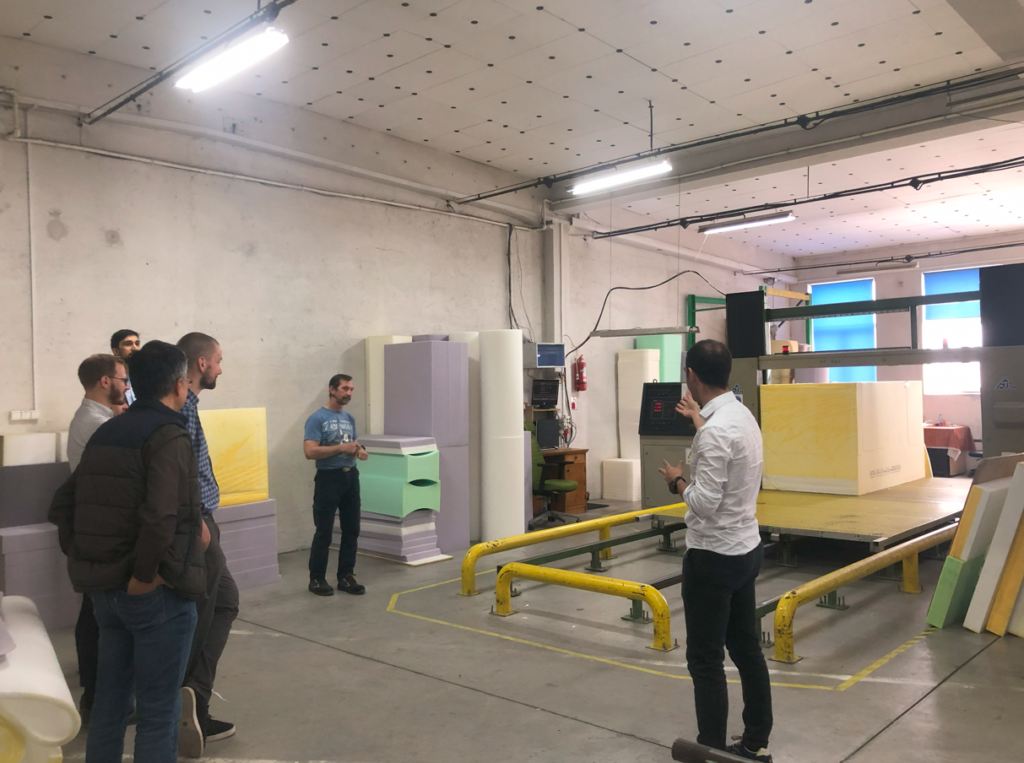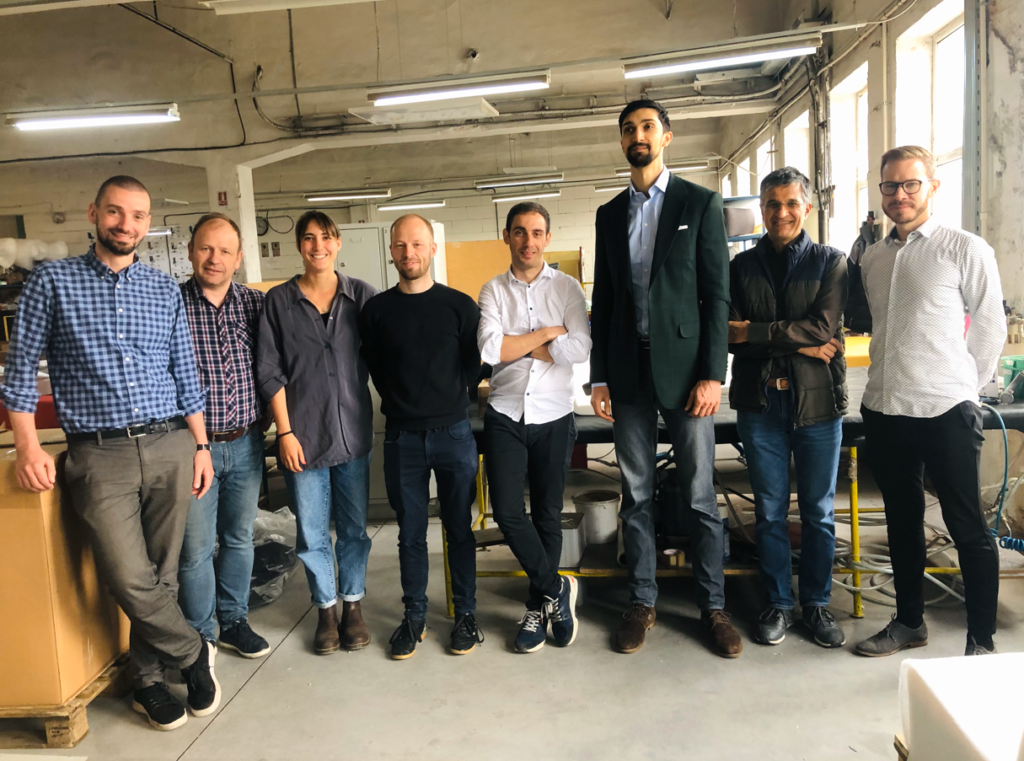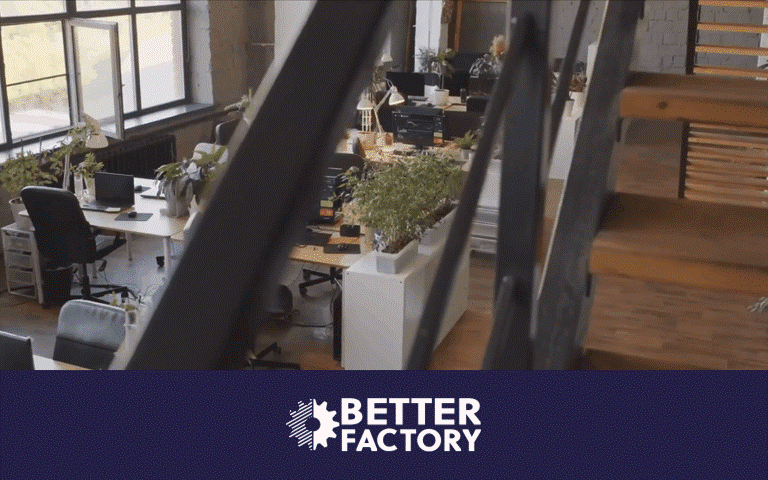Over the next couple of weeks we’ll be running a series of 1:1 interviews with the KTE (Knowledge Transfer Experiment) teams that joined Better Factory through our second open call. These incredible teams are each made up of a SME, artist and technology provider, working together to develop new and personalized products, become cyber-physical systems, and transforming into Lean-agile production facilities.
The OCCE project will focus on rethinking an existing office chair from the manufacturer, Antares, which is rethought from the principles of circularity.
Their KTE team includes:
- Antares Romania (Manufacturing company)
- Enrichers (Artist)
- Comfrac Green Energy (Technology Provider)
Without further ado, let’s dive into the interview!
Hello, thank you for joining us! To start off, could you tell us why you decided to apply to Better Factory?
SME Antares Romania: It is inherently human to progress and develop. In current times, a factory like Antares Romania dedicated to the production of ergonomic chairs or office furniture represents much more than a simple assembly line. To maintain a competitive edge, it becomes imperative to create high-quality products, perfectly tailored to the ergonomic and durability requirements of the contemporary era, without neglecting aspects of design, technology, employee morale, or recyclability/sustainability.
We participated in Better Factory with the firm goal of evolving, of becoming more competitive. We are convinced that nowadays we need to be much more receptive to a variety of perspectives, both creatively and technologically. Collaboration with various technological and artistic fields becomes essential. But how can we achieve this ambitious objective? Better Factory has provided us with the unique opportunity to bring together a manufacturer (SME), an artist, and a technology provider in a mutually beneficial collaboration for all involved parties.
Artist Enrichers: As a product designer you always want to make an impact with creativity. With Better Factory you are formulating the assignment with the SME. This guarantees the relevance of the assignment. Prior to taking part, I had the opportunity to already visit the factory. This made it possible to formulate a concrete yet challenging assignment. It is unique to reformulate circular design for desk chairs and have the possibility to directly implement it into practice.
Tech provider Comfrac Green Energy: Nowadays, we observe a tremendous speed of evolution in the digital technology available for business and industrial use. Better Factory is a great catalyst for the adoption of state of the art technologies by providing companies the opportunity and support to test and evaluate the impact of digital technologies on all aspects of manufacturing. I believe that Better Factory is at the forefront of this movement, and I’m excited to be a part of it.

Can you tell us more about the challenges you expect to face while rethinking the existing office chair from Antares to make it circular?
SME Antares Romania: The challenge is immense, as in addition to adhering to the principles of circular economy, the chair must also be comfortable and possess an appearance accepted by the end consumer at a reasonable cost. The greatest challenge is to successfully fulfill all these three requirements within a single product.
Another hurdle we face is attempting to shift the paradigm in the medium and long term. Allow me to explain further: in today’s world, consumers often don’t prioritize whether a product is recyclable, sustainable, or part of the circular economy. From our experience, they primarily make choices based on price. Changing a product is much more difficult than repairing it, and this is not limited to the furniture industry; it applies across various industrial sectors. In this project, our aim is to extend the lifespan of a product, to double or even triple it. We can achieve this by creating a product that is easily repairable and by offering customers long-term solutions. We aspire for the ergonomic chair we create to be used for 10-15 years, or even longer. That’s why we’re committed to providing restoration solutions as well, or even buy-back solutions, where we can reuse some components.
Artist Enrichers: It is not difficult to design a chair from recycled materials or with dismantable components. But grinding a chair into a base material again consumes energy and requires a system to make sure materials are properly separated. The material quality often also goes down every time you recycle it. Dismantling a chair is often more time consuming than making the chair from scratch. This means a refurbished chair is still more expensive than a new chair, making circularity often difficult to apply economically.
“The real challenge is to design a desk chair that takes less time to dismantle and refurbish, that making it new.”
Artist Enrichers
Tech provider Comfrac Green Energy: One of the key principles of circularity is designing products for disassembly and repair. This means that the Antares office chair should be easy to take apart so that the individual components can be reused or recycled. It also means that the chair should be easy to repair so that it can be kept in use for longer. We are looking forward to identifying the best solutions from the RAMP APPS to support this transition to circularity.
How do you think the Better Factory technologies and APPS will help you in the manufacturing process?
SME Antares Romania: The Better Factory technologies and APPS are digitizing many of our current processes. It’s easy to understand that this provides us with a clearer, faster picture where we can make better decisions. Another aspect is the simulation of production lines in a digital format, and if one of the results is satisfactory, it can be physically implemented in the factory. This gives us the opportunity to streamline costs, increase productivity, and improve the quality of products.
Artist Enrichers: With data from current production time, you can make a benchmark of what you need to improve. Also the ability to track motions from factory workers helps to understand how movement relates to emotions and how the production process can be reimagined. With the Motion Design Workshop, we are going to explore what movements factory workers like to make in their leisure time and how these movements can be integrated into the production process. What insights does the analysis of mapping movements provide to redesigning the desk chair itself?

What value do you think the OCCE project brings to the industry, and how do you see it impacting the market for office chairs?
SME Antares Romania: I believe it is too early to discuss this aspect at this point. One of the key values that we would like to change is the paradigm of values that will need to be reconsidered for end consumers as well as for producers: we believe that the environment should come first, followed by other factors such as profit or financial cost. I think if we succeed in this project, the thing mentioned above (circularity) will start to gain importance în the choice of our communities, thus the industry will start to be more circular and will pay more attention to the environment.
Artist Enrichers: Hopefully we managed to understand well how a variety of materials can be designed to be circular when it comes to sitting. It would be great when the designed can become an example of what circularity looks like.
Tech provider Comfrac Green Energy: The OCCE project is a valuable initiative that has the potential to make a significant impact on the office chair market. The project aims to develop a circular economy for office chairs, which would mean that office chairs could be reused, repaired, and recycled at the end of their life. This would help to reduce waste in the manufacturing industry and would also make office chairs more sustainable.

What are your expectations for the future of circular design and production in the office chair industry, and how do you think the OCCE project can pave the way for other manufacturers to follow suit?
SME Antares Romania: The main argument is the environment in which we live day by day. If we succeed in designing a product that protects the environment and people will value this, then it will be easy to pave the way for other manufacturers, since they will adapt to the needs of the customers, which will ask for products that respect the circular economy.
“I believe that the future of circular design and production in the office chair industry is very bright. The OCCE project is a great example of how circular design can be used to create more sustainable and affordable office chairs. I believe that other manufacturers from various domains will follow suit and start to adopt circular design principles, driven by a growing consumer demand for sustainable products.”
Tech provider Comfrac Green Energy
Artist Enrichers: First of all, the design of the OCCE project should be clear visualisations of what circular design is. That is something we can control within the consortium. After that, it will all depend on marketing. How well is it going to be presented at fairs, how well can the story be told, how much budget will there be to make a good marketing campaign. Considering the marketing communication is not part of the scope of the project, little can be said about how far this project will reach. Therefore, how influential these designs will be.
Tech provider Comfrac Green Energy: At the same time, technological advancements are making it easier to design and produce circular products and the OCCE project provides a blueprint for how to design and produce circular office chairs. This blueprint can be used by other manufacturers to create their own circular products.
If you’d like to learn more about OCCE and their experiment, don’t forget you can check out their KTE page here!

